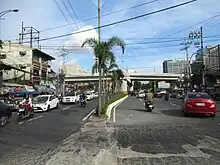.svg.png.webp) | |
|---|---|
_02.jpg.webp) Kalayaan Avenue looking west from C-5 Road in West Rembo | |
| Former name(s) | Pasig Line Street Imelda Avenue |
| Length | 6.3 km (3.9 mi) |
| Component highways |
|
| Location | Makati and Taguig |
| West end | Zobel Roxas Street at Makati–Manila boundary |
| Major junctions |
– – Bel-Air Village – –
|
| East end | J.P. Rizal Extension at East Rembo, Taguig |
Kalayaan Avenue is a major east–west route in Makati and Taguig, Metro Manila, Philippines. For most of its length, it runs parallel to Jose P. Rizal Avenue to the north from East Rembo near Fort Bonifacio to Barangay Singkamas by the border with Santa Ana, Manila. It is interrupted by Bel-Air Village between Rockwell Drive and Epifanio de los Santos Avenue (EDSA). The avenue east of EDSA is designated as a component of National Route 190 of the Philippine highway network.
History
Kalayaan Avenue was formerly called Pasig Line Street as it mostly followed the defunct Paco–Pasig tram line of the Manila Electric Railway (operated by Meralco) for most of its length; the street in the district of San Andres in Manila still bears that name. The line was built in 1908 but was heavily damaged during World War II.[1][2][3] Subsequent development of the Bel-Air Village by Ayala Corporation in 1957 has led to the closure of a segment of Pasig Line west of EDSA.[4] During the term of President Ferdinand Marcos, the road was improved and was renamed to Imelda Avenue after his wife and first lady, Imelda Marcos. Following the overthrow of the Marcos regime, the Makati local government renamed the avenue to Kalayaan (Filipino word for "Freedom").
Route description
West Kalayaan

The western section begins as a four-lane road at the intersection with Zobel Roxas Street at the border of Makati and Manila, continuing the Pasig Line Street in San Andres, Manila. It cuts across the northern portion of the city traversing barangays Singkamas, Tejeros, Santa Cruz, Olympia, Valenzuela, Bel-Air, and Poblacion. Starting as a two-way road, it becomes a one-way eastbound road from Pasong Tirad Street in Tejeros. Between South Avenue and Nicanor Garcia Street, Kalayaan bounds the Manila South Cemetery and the former Makati Catholic Cemetery to the south. It crosses into the western edge of Bel-Air and Población where St. Andrew the Apostle Parish could be found. Kalayaan then becomes a two-way road once again at the vicinity of Century City. East towards the intersection with Makati Avenue, Kalayaan is dominated by the Century City and Picar Place developments on the northern side. At Makati Avenue, the road traverses a major entertainment and hotel district, with many nightclubs, bars and mid to low range hotels in the immediate vicinity. The section of Kalayaan east of P. Burgos Street is home to many sports pubs. It ends at a merge with Rockwell Drive by the entrance to the gated Bel-Air Village, where it continues as Mercedes Street.
East Kalayaan

East of Bel-Air at the intersection with EDSA in Barangay Pinagkaisahan, the avenue picks up as a 6-8 lane divided highway. It runs underneath the Kalayaan Flyover as it heads towards the entrance to Bonifacio Global City, entering Barangay Pitogo and, therefore, Taguig. It veers northeast at the junction with 32nd Street thereby bypassing the Bonifacio Global City. The road continues in this manner as it heads into Guadalupe Nuevo, where it briefly returns to Makati before re-entering Taguig at Cembo. It bends eastwards just before coming to an intersection with 8th Avenue in West Rembo. The road crosses 8th Avenue and then Carlos P. Garcia Avenue (C-5) at the Circumferential Road 5–Kalayaan Avenue Interchange and ends at J.P. Rizal Extension in East Rembo. It then continues towards San Joaquin, Pasig as San Guillermo Avenue.
Landmarks
From west to east:
References
- ↑ "Laguna Railways: Pasig Line". Railways and Industrial Heritage Society of the Philippines, Inc. Retrieved October 12, 2013.
- ↑ "Pictures and thoughts from a break". Panaderos. Retrieved October 12, 2013.
- ↑ Manila and Suburbs (Map). July 25, 1944. Retrieved October 21, 2021.
- ↑ bonitm History and Facts published by Barangay Bel-Air; accessed October 12, 2013.
